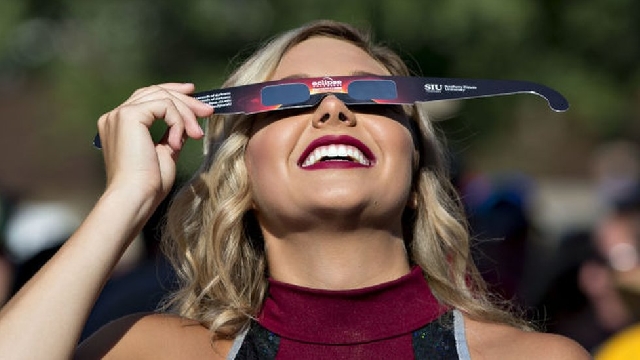Solar eclipse 2024: Millions in North America will view what promises to be a blockbuster
 Watching the eclipse
Watching the eclipse
How lucky can the residents of Carbondale, Illinois, be?
Celestial mechanics says any one spot on the Earth's surface should experience a total solar eclipse only once every 375 years, on average.
The 30,000 residents of the Midwestern city will probably chuckle at that statistic because they are about to witness the Moon block out the Sun's disc for the second time in just seven years.
And what's more, the upcoming 8 April eclipse will be even better than the one they got to see in 2017. The sky will go pitch black for 4 minutes and 9 seconds, nearly double what happened last time.
As many as 200,000 people are expected to flood prime viewing locations in southern Illinois for The Great American Eclipse, Part II. But this will be true, also, all along the eclipse path, from Mexico's Pacific coast to Canada's Atlantic seaboard. The upcoming event is set to be a blockbuster.
In 2017, the path of deepest shadow - "totality" - ran from Oregon in the US north-west to South Carolina in the south-east. That actually covered some sparsely populated regions, including many national parks.
The 2024 event, in contrast, will cover some major US urban areas, such Dallas, Indianapolis, Cleveland, and Buffalo.
"This is going to be the most populated eclipse in the US, with 31.5 million people able to just walk outside of their homes to experience it," Dr Kelly Korreck, the US space agency's eclipse programme manager, told BBC News.
As you'd expect, Nasa will be doing understated experiments on the day, such as launching rockets into the shadow cast by the Moon to see how it affects the top of the Earth's atmosphere, or its ionosphere. Instrumented jet planes will also chase the shadow.
"The reason that we're flying aeroplanes, besides the fact that it's really cool, is because getting up high into the atmosphere means you can actually access wavelengths of light you can't do from the ground," said Dr Amir Caspi from the Southwest Research Institute.
The 2024 total solar eclipse will begin way out in the Pacific Ocean, with the inhabitants of Penrhyn Atoll, part of the Cook Islands, greeted by a darkened Sun at dawn, at 06:40 CKT (16:40 GMT).
The Moon's shadow, or umbra, will then race across the Earth's surface at more than 2,500km/h (1,500mph), crossing the Mexican coast at 11:07 MST (18:07 GMT) and the Rio Grande border between Mexico and the US at 13:27 CDT (18:27 GMT).
The journey continues up through 13 US states, before sweeping into the Canadian provinces of New Brunswick (16:32 ADT; 19:32 GMT) and Newfoundland (16:39 ADT; 19:39 GMT).
The Moon's shadow will lift off the Earth's surface in the Atlantic Ocean at 21:55 CEST (19:55 GMT), about 1,120km (700 miles) west of Normandy, France.
Sorry, Europe; maybe next time.
Keen sky-watchers largely have their plans already in place.
They'll have studied transport and accommodation options and paid close attention to historic weather patterns.
The chances of avoiding confounding clouds are best in Mexico and Texas. But in truth, on any one day, in any one place, the weather could be your friend or a killjoy - and that applies to Carbondale, too.
You might think that with all the space telescopes trained on the Sun these days that there's very little an eclipse can add to the sum of solar knowledge.
But total eclipses are special because they afford favourable conditions to study the tenuous outer atmosphere of the Sun - its corona.
It is in this magnetised, superheated "gas" of charged particles that the solar wind originates, and from which billions of tonnes of matter can occasionally burst towards the Earth to disrupt satellites, communications and even electricity grids.
The corona is outshone by the Sun's surface, its photosphere. Satellites will block out the glare using devices called coronagraphs, but those are usually so wide that they also obstruct the view of light immediately above the edge of the star. It's in this zone where the corona's key processes are occurring.only during an eclipse, when the Moon's disc just matches that of the Sun, do all aspects of the corona become accessible.
British scientists have teamed up with Nasa to deploy instruments in Dallas. They'll have a polarimeter to examine the directional quality of the corona's light and a spectrometer to look for the behaviour of excited iron atoms.
"During an eclipse, nature gives us a unique opportunity to measure this region with relative ease, and to see the connections between the Sun and solar wind," explained Dr Huw Morgan from Aberystwyth University.
Source: BBC
Trending News

Akufo-Addo advocates transparency in Judiciary as he swears in 16 Appeal Court judges
02:48
Any attempt to illegally freeze our salaries would lead to legal action – CETAG
10:11
Gov't's commitment to reducing carbon footprint unwavering – Herbert Krapa
07:10
Water supply in Keta not improved – KIPC
06:04
Bagbin calls for legislative cap on SC justices
10:12
Africa: Road crash deaths rise by 17% – WHO
06:48
Dep. IGP in charge of operations: Akufo-Addo has set Yohonu on conflict course with Dampare - Asiedu Nketia
10:51
Withhold July salaries of striking Colleges of Education teachers – GTEC to Accountant General
10:12
NCA assures public of lower data prices by year-end amid criticism over high costs
06:19
Dec polls: Be transparent, impartial – Group to EC
10:31



